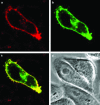G-protein-coupled receptors: past, present and future
- PMID: 16402114
- PMCID: PMC1760739
- DOI: 10.1038/sj.bjp.0706455
G-protein-coupled receptors: past, present and future
Abstract
The G-protein-coupled receptor (GPCR) family represents the largest and most versatile group of cell surface receptors. Drugs active at these receptors have therapeutic actions across a wide range of human diseases ranging from allergic rhinitis to pain, hypertension and schizophrenia. This review provides a brief historical overview of the properties and signalling characteristics of this important family of receptors.
Figures




Similar articles
-
Pharmacology of intracellular signalling pathways.Br J Pharmacol. 2006 Jan;147 Suppl 1(Suppl 1):S38-45. doi: 10.1038/sj.bjp.0706468. Br J Pharmacol. 2006. PMID: 16402119 Free PMC article. Review.
-
G protein-coupled receptors: an overview of signaling mechanisms and screening assays.Methods Mol Biol. 2015;1272:3-19. doi: 10.1007/978-1-4939-2336-6_1. Methods Mol Biol. 2015. PMID: 25563173 Review.
-
Historical review: a brief history and personal retrospective of seven-transmembrane receptors.Trends Pharmacol Sci. 2004 Aug;25(8):413-22. doi: 10.1016/j.tips.2004.06.006. Trends Pharmacol Sci. 2004. PMID: 15276710
-
A Key Opinion Leader interview: insight into the research and career of Dr KA Jacobson.Expert Opin Ther Pat. 2015 Jan;25(1):125-9. doi: 10.1517/13543776.2015.993539. Epub 2014 Dec 12. Expert Opin Ther Pat. 2015. PMID: 25495234 Free PMC article. No abstract available.
-
Endomembrane GPCR signaling: 15 years on, the quest continues.Trends Biochem Sci. 2025 Jan;50(1):46-60. doi: 10.1016/j.tibs.2024.10.006. Epub 2024 Nov 11. Trends Biochem Sci. 2025. PMID: 39532582 Review.
Cited by
-
A Study on the Robustness and Stability of Explainable Deep Learning in an Imbalanced Setting: The Exploration of the Conformational Space of G Protein-Coupled Receptors.Int J Mol Sci. 2024 Jun 14;25(12):6572. doi: 10.3390/ijms25126572. Int J Mol Sci. 2024. PMID: 38928278 Free PMC article.
-
A study of antagonist affinities for the human histamine H2 receptor.Br J Pharmacol. 2008 Mar;153(5):1011-21. doi: 10.1038/sj.bjp.0707644. Epub 2007 Dec 24. Br J Pharmacol. 2008. PMID: 18157166 Free PMC article.
-
Biased Signaling Agonists Promote Distinct Phosphorylation and Conformational States of the Dopamine D3 Receptor.Int J Mol Sci. 2024 Sep 28;25(19):10470. doi: 10.3390/ijms251910470. Int J Mol Sci. 2024. PMID: 39408798 Free PMC article.
-
Profiling gene expression induced by protease-activated receptor 2 (PAR2) activation in human kidney cells.PLoS One. 2010 Nov 2;5(11):e13809. doi: 10.1371/journal.pone.0013809. PLoS One. 2010. PMID: 21072196 Free PMC article.
-
High-level expression in Saccharomyces cerevisiae enables isolation and spectroscopic characterization of functional human adenosine A2a receptor.J Struct Biol. 2007 Aug;159(2):166-78. doi: 10.1016/j.jsb.2007.05.001. Epub 2007 May 16. J Struct Biol. 2007. PMID: 17591446 Free PMC article.
References
-
- BAKER J.G., HALL I.P., HILL S.J. Agonist and inverse agonist actions of β-blockers at the human β2-adrenoceptor provide evidence for agonist-directed signalling. Mol. Pharmacol. 2003;64:1357–1369. - PubMed
-
- BANERES J.L., PARELLO J. Structure-based analysis of GPCR function: evidence for a novel pentameric assembly between dimeric leukotriene B4 receptor BLT1 and the G-protein. J. Med. Biol. 2003;329:815–829. - PubMed
Publication types
MeSH terms
Substances
Grants and funding
LinkOut - more resources
Full Text Sources
Other Literature Sources
Miscellaneous

